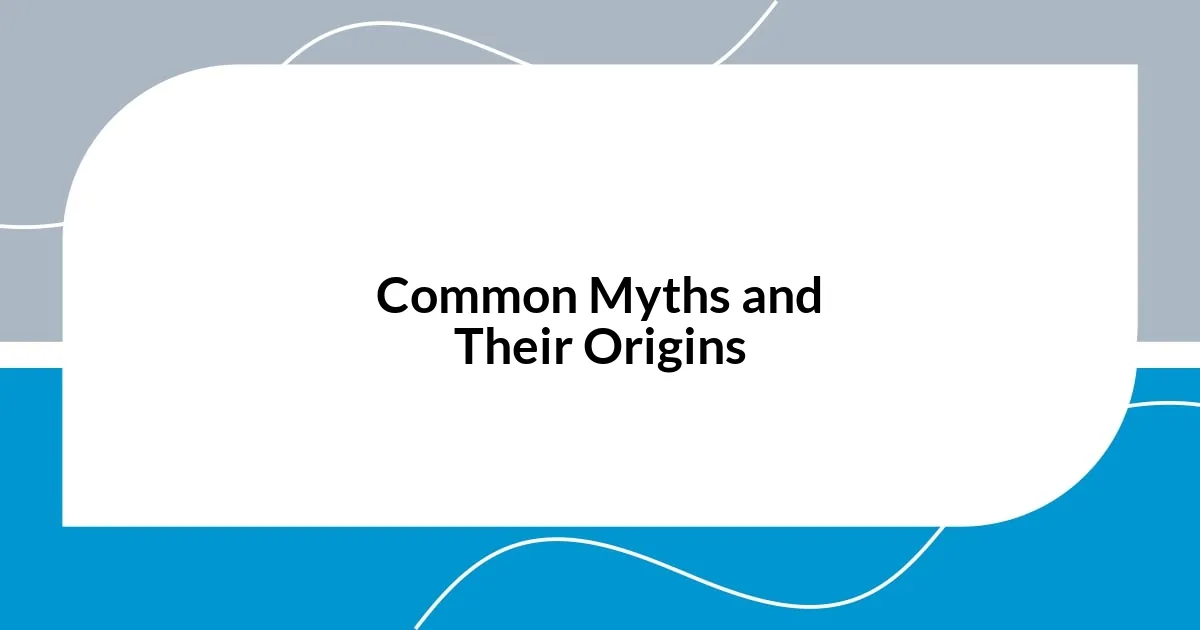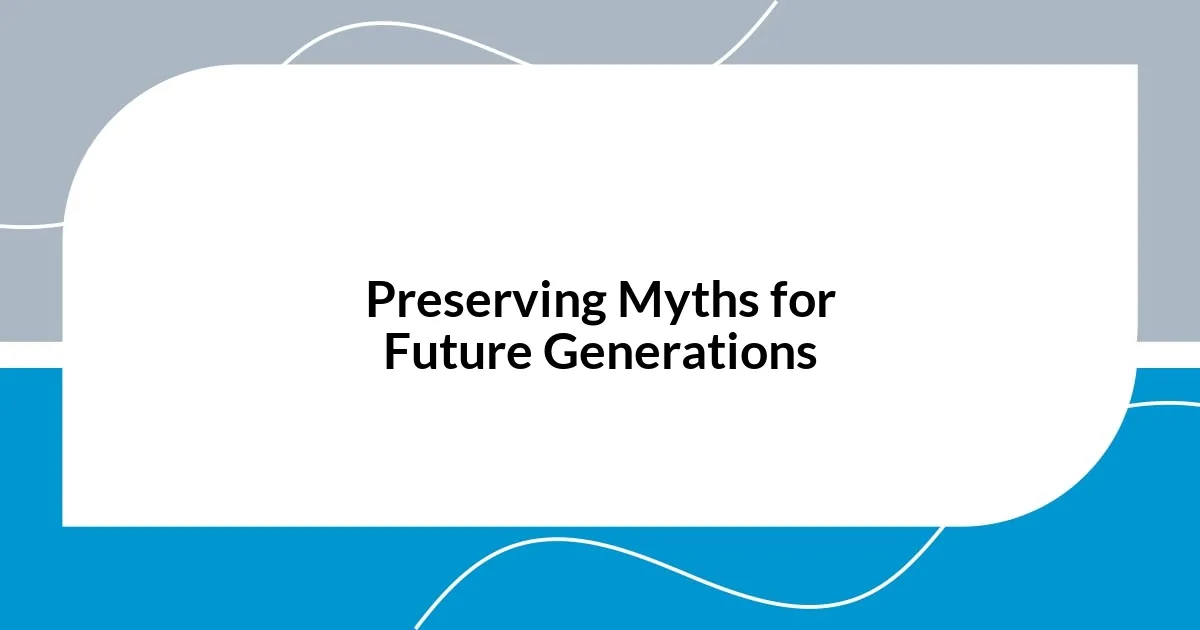Key takeaways:
- Local myths are integral to community identity, connecting generations and reflecting shared values and fears.
- Myths often originate from historical events, evolving over time into stories that offer moral lessons and a sense of wonder.
- The preservation of these stories is essential for passing down cultural heritage and inspiring curiosity in future generations.
- Innovative approaches, such as technology, could help keep local myths alive and engaging for new audiences.

Introduction to Local Myths
Local myths have a unique way of weaving themselves into the fabric of our communities, offering us stories that connect generations. I can still remember sitting around the campfire as a child, captivated by my grandmother’s tales of the ghost that supposedly roamed our town’s oldest bridge. Those stories, filled with mystery and intrigue, lingered in my mind, shaping my view of our town’s identity.
These myths often reflect our values, fears, and beliefs, creating a shared cultural narrative. Have you ever considered why certain tales stick with us? In my experience, myths often serve as moral lessons or warnings, illustrating the boundaries of acceptable behavior while entertaining us at the same time. It’s fascinating to think how these stories evolve, sometimes morphing into something almost unrecognizable as they get passed down.
As we explore these old myths, I find that they spark a sense of curiosity about their origins. It’s like uncovering a hidden layer of our town’s history—each story a breadcrumb leading us deeper into our collective past. And isn’t it comforting to know that, no matter how strange or improbable, these myths often bring us together, allowing us to bond over our shared wonder and imagination?

Historical Background of My Town
Historical Background of My Town
My town, founded in the early 1800s, carries a rich tapestry of events that have shaped its identity. One of my favorite stories revolves around the annual harvest festival, which dates back to the town’s first settlers. I remember attending as a child, the air filled with the savory scent of roasted corn, and it struck me how these gatherings echoed the resilient spirit of the early community. Those festivities were not just celebrations; they were a testament to survival and unity against the odds.
- Established in 1823, my town served as a vital trade hub due to its strategic location near the river.
- The original settlers were primarily farmers and artisans, contributing to the town’s vibrant economy.
- Over the decades, various events, from wars to natural disasters, have left lasting marks on our cultural landscape.
- I often think about the stories my mother told me about the old mill that powered our town in the early years – it felt alive with history, much like the myths we still share today.

Common Myths and Their Origins
Myths often have roots in historical events or figures that become embellished over time. For instance, I recall hearing as a kid about a notorious outlaw who used to haunt the outskirts of our town. Rumors swirled around him, claiming he still roamed the very woods I played in, searching for his stolen treasure. This myth, while likely exaggerated, beautifully illustrates how tales can grow from a grain of truth, evolving into gripping stories that spark our imagination and connect us to our past.
Another long-held belief in my town is the legend of the old oak tree in the park, said to grant wishes if you tie a ribbon to its trunk. During my teenage years, my friends and I often found ourselves there under the moonlight, sharing dreams and secrets, believing somehow that the magic of the tree helped us navigate our ambitions. I’ve always felt these myths serve a purpose, creating a sense of wonder and hope in our everyday lives. They offer us a way to articulate desires and fears, turning simple moments into something profound.
As we uncover these common myths, I notice that many stem from a blend of cautionary tales and celebrations of bravery. I remember the spooky stories of the abandoned house at the end of my street, where we dared each other to approach. Those tales not only gave us chills but also shaped our boundaries—what we should and shouldn’t do in pursuit of adventure. In essence, every myth encapsulates lessons intertwined with our community’s spirit, enriching the narrative of our shared existence.
| Myth | Origin |
|---|---|
| Haunted Bridge | Rumors of a ghostly figure linked to a tragic accident. |
| Outlaw in the Woods | Based on a real outlaw from the town’s early days, exaggerated through storytelling. |
| Wish-Granting Oak Tree | Originated from early settlers’ rituals, now a symbol of hope. |
| Abandoned House Tales | Children’s dare stories evolved from historical fears of the unknown. |

Cultural Significance of Myths
Myths serve as a cultural backbone, binding communities through shared narratives. Each tale carries the weight of history, often reflecting the values, fears, and aspirations of the people. When I hear stories about local legends, I feel a sense of belonging, as if the fabric of my identity is intertwined with these tales. They remind me of our collective experiences, anchoring us to our roots.
I can’t help but think about how myths spark our imaginations, especially in a place like my town. They transform ordinary places into realms of adventure and mystery. For instance, the legend of the haunted bridge makes me ponder: what if, as children, we were drawn to the thrill of those stories more than the fear? I remember crossing that bridge, my heart racing, convinced that I could feel the presence of the past. In those moments, the myths felt like they were whispering secrets of the town’s history that we were privileged to hear.
Furthermore, I believe these myths provide important life lessons. They teach us resilience, caution, and even hope. Reflecting on the wish-granting oak tree, there’s something beautifully comforting in tying a ribbon to its trunk—it’s almost like you’re sharing your dreams with a friend who’s silently rooting for you. I wonder how many others stood there, just like me, feeling a glimmer of hope with each wish made, knowing that myths help us navigate life’s uncertainties by providing us with a narrative framework.

Myths Impact on Local Identity
The impact of myths on local identity is undeniable; they shape the way we perceive ourselves and our community. I often think about how stories of the haunted bridge became a rite of passage for many of us. Every Halloween, my friends and I would challenge each other to cross it at midnight—our hearts racing with both fear and excitement. In those moments, we weren’t just facing a bridge; we were actively participating in a shared narrative that defined who we were as a town.
I believe these myths cultivate a sense of pride among residents. For example, the legend of the outlaw who roams our woods isn’t merely a ghost story; it’s a reflection of our town’s maverick spirit. I remember the pride I felt when recounting this tale to others, almost like I was sharing a piece of our communal heritage. This connection to our myths fosters a unique bond that transforms strangers into friends, united by a common story.
As I reflect on these narratives, I can’t help but feel that they provide us with a lens through which we view our town. The wish-granting oak tree, for instance, isn’t just a tree to me; it symbolizes hope and possibility. I recall tying a sturdy ribbon around it during a particularly challenging time in my life, whispering my dreams into the night. That simple act made me feel supported by generations of dreamers before me, showcasing how our myths not only shape local identity but also inspire personal growth within it.

Personal Reflections on Local Myths
Reflecting on local myths always stirs a nostalgic sense of wonder within me. I vividly remember sitting around a campfire with friends, wrapped in warm blankets and sipping hot cocoa, sharing stories of the phantom that supposedly lingers in the old mill. As each person took their turn to recount the chilling details, I could feel a tangible energy in the air—laughter mixed with shivers. It made me realize how these tales not only entertain but also create a unique bond among us, as we collectively navigate our fears and curiosities.
In another instance, I found myself revisiting the story of the mysterious lights that dance above the lake on clear nights. One summer evening, I decided to kayak out to the center, my heart racing with a mix of thrill and apprehension, hoping to catch a glimpse. As the sun dipped below the horizon, painting the sky in shades of orange and purple, I felt a strange connection to those who had ventured there before me, chasing the same glowing phenomenon. It struck me then that these myths are more than just fanciful stories; they compel us to seek adventure and push the boundaries of our understanding.
What fascinates me the most is how these myths can shape our understanding of life’s unpredictability. I remember during a particularly tough period when I visited the infamous wishing well. I tossed in a coin, my heart heavy with unsaid words and unresolved struggles, and I found solace in the collective hope found in each ripple on the water’s surface. It made me ponder: how many others had stood there, anchoring their dreams in the same spot? I realized that these myths serve as a gentle reminder that hope is a universal thread, connecting past, present, and future dreamers in our little corner of the world.

Preserving Myths for Future Generations
Preserving our town’s myths is like safeguarding treasure. I often think back to the storytelling nights at my grandmother’s house. She’d share tales of mythical creatures from our woods, her eyes alight with passion. Those memories instilled in me a responsibility to keep these stories alive, ensuring future generations can feel the magic woven in our history.
There’s something incredibly powerful about passing down these narratives. I remember the first time I told the story of the cursed pond to my younger cousin. She listened wide-eyed, completely mesmerized. Watching her react made me realize that, in preserving these myths, we’re not just sharing stories — we’re igniting curiosity and imagination in the hearts of children who will one day share them, too.
What if we could embed these myths into our daily lives? I’ve often pondered how modern technology might help. Imagine an app that allows locals and visitors alike to explore our myths through interactive maps or augmented reality experiences! That blend of tradition and innovation could keep these tales vibrant, ensuring they thrive well into the future. Wouldn’t it be amazing to have new generations roaming these stories just like I did, firmly grasping our town’s legacy?